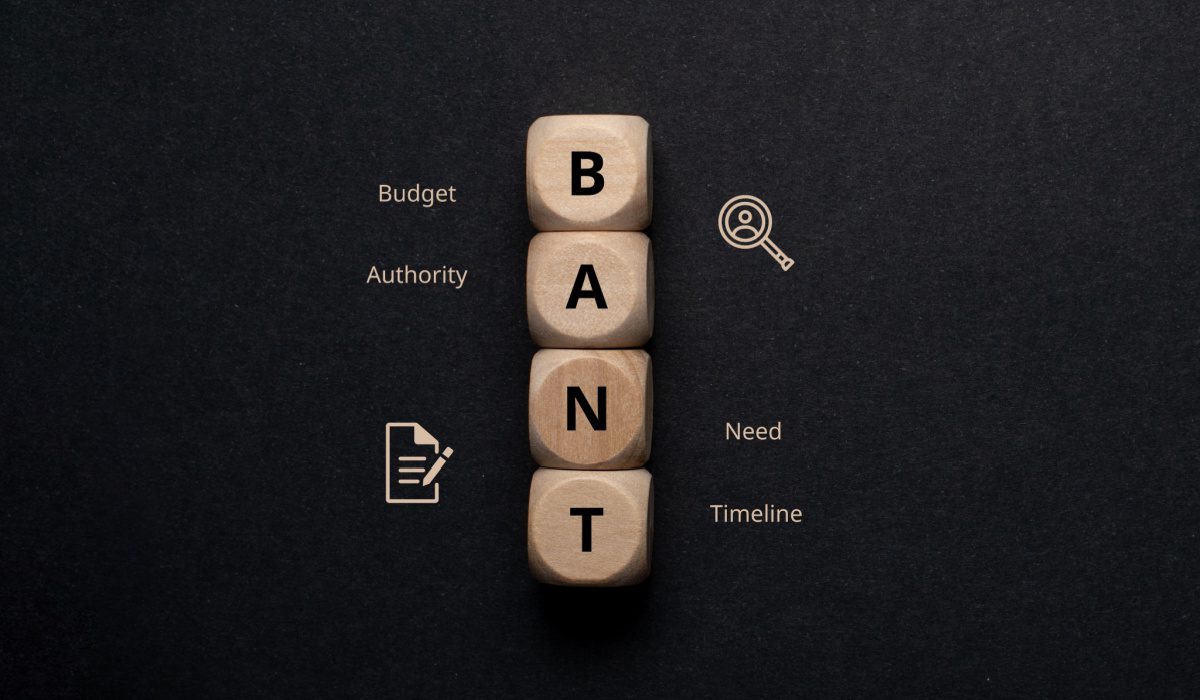
In the world of sales, closing deals is the ultimate goal. However, the sales process can be complex and overwhelming, especially when dealing with potential customers who aren’t ready to purchase. A proven B2B BANT sales framework is essential to increase your chances of closing deals.
Sales representatives utilize the BANT framework to evaluate if a potential customer is suitable for the product or service. Moreover, BANT helps salespeople focus on strong prospects and is popular B2B lead generation tactic.
First and foremost, let’s dig into the BANT framework and the key elements that build it.
Elements of the BANT Sales Process
The BANT sales framework is an acronym that stands for Budget, Authority, Need, and Timeline. Each factor plays a crucial role in the sales process and can help you determine whether a lead is qualified and ready to purchase. Moreover, this sales process raises a few requisite BANT framework questions you must focus on.

Let’s take a closer look at each of these factors:
- Budget: You should first assess a potential customer’s budget. This will show if they can afford your goods or service. Sales may be pointless without a budget.
- Authority: Sales decision-makers must be identified. Without talking to the buyer, it’s hard to move further. Use questions to identify and speak to the decision-maker.
- Need: Knowing potential customers’ wants is crucial. This will help you assess your product or service’s fit. Inquire about their pain spots and inform them how your product or service might help.
- Timeline: Recognize when the potential consumer needs to buy. They may not buy instantly unless they have an urgent need. If they need a solution immediately, utilize that haste to your advantage.
Also Read: Promising B2B Lead Nurturing Strategies for Successful Sales Closure
At the beginning of the sales process, BANT serves as a checklist that you need to validate with a potential customer to verify if their interests align with your company’s offerings. BANT sales framework qualifies leads, determines whether they will likely become customers, and improves your bottom line.
Here are some reasons why adopting the BANT sales qualification framework can be beneficial for your business:
- Qualifies leads
- Improves sales productivity
- Enhances targeting
- Increases conversion rates
- Improves forecasting
- Helps diagnose and overcome objections
Now that you understand the definition of the BANT framework and its key benefits, it is time to concentrate on implementing it in your business operations.
Process for Utilizing the BANT Sales Framework
BANT is a simple and effective tool for qualifying leads and assessing the likelihood of a successful sale. But how do you apply it successfully? Let’s discuss the steps required to use the B2B BANT framework to identify and rank qualified sales leads.
To use the BANT framework:
- Ask questions about the prospect’s budget, such as how much they will spend on a solution.
- Determine if the prospect has the authority to make purchasing decisions.
- Identify their specific needs and pain points.
- Establish a timeline for the purchase.
Using the B2B BANT sales qualification framework, sales professionals can prioritize leads and focus their efforts on those most likely to result in a sale. It can also help identify potential roadblocks early in the sales process and tailor the pitch to the prospect’s specific needs and concerns.
Let’s thoroughly examine and analyze the central aspect of the blog by delving deeply into the steps involved in the BANT process and discussing it in detail.
Steps for utilizing the BANT Sales Framework
-
Know more than the prospect’s budget
The prospect’s budget must be understood beyond just a financial number. Asking about the prospect’s expected ROI might help you overcome pricing barriers while selling your product. You should check the prospect’s budget to see whether the ROI matches your pricing. If it matches, you could qualify that prospect based on budget.
Salespeople may identify eligible clients, understand their financial needs, and customize their sales approach by taking a more sophisticated approach to budget-related talks.
-
Determine decision-making stakeholders
Usually, more than one person is responsible for most decisions. Deals typically involve three stakeholder groups. Most of the team must be convinced even if one person signs the contract.
-
Identify process participants
Consider everyone involved in the process: Their job titles, priorities, decision-making roles, and ways to reach them. More connections mean more significant influence and a lower chance of missing this opportunity.
-
Prioritize the issue
Determine how essential this issue is to the prospect. A prospect might say and mean that they have a specific requirement, but the team’s or senior leadership’s priorities may be different. Make every effort to identify the needs of your prospects, team, and leaders as early as feasible.
-
Create a schedule for the sales process
After identifying your budget, decision-makers, and product requirement, you must decide how quickly their company must decide. Knowing if a deal will require months of approvals or a simple one-pitch-and-close can help you manage your pipeline and prepare for the closing.
-
Multiple channels for information
This one step of the BANT qualification framework will allow you to anticipate the prospect’s objections, delays, and concerns. Keeping track of pending transactions can help you resolve new demands your product can fulfill.
Informal communication can help you qualify a prospect using the data you acquire. This will provide you with a complete picture of the prospect to determine if they are a good match for your product.
Also Read: How are Sales Performance and Customer Experience Directly Proportional to Sales Enablement?
-
Track your progress digitally
Implementing BANT into your sales process will be facilitated using digital tools that monitor your pipeline and manage relationships. As you work with multiple prospects simultaneously, you can determine precisely where you left off with each one and how far they still need to go before the transaction is concluded.
How to Qualify Leads with BANT
The BANT framework is a well-known tool that sales and marketing experts utilize to evaluate leads before pursuing them further. Its popularity stems from its effectiveness, memorability, and adaptability to various products, price points, and sales processes. Combining this framework with thoughtful questions naturally arising in a two-way conversation is crucial.
Many people mistakenly believe this process and framework is outdated in today’s sales process. However, you can unearth valuable information once integrated into your business model.
To enhance your BANT strategy, you must evolve it to include more questions that help you qualify more leads and secure better deals. B2B BANT framework questions are especially important as they enable you to determine if the lead is the right fit for your business. By refining and expanding your BANT framework questions, you can qualify leads more effectively, increasing sales and revenue. There are various B2B lead generation companies out there to guide you with the best BANT framework.
Upsides and Downsides of Incorporating BANT into Your Sales Qualification Process
The B2B BANT qualification framework has been widely used in sales and marketing for many years, offering several benefits and drawbacks.
Pros:
- Efficient: BANT helps to streamline the lead qualification process by providing a clear set of criteria that needs to be met before pursuing a lead further.
- Saves time: It enables sales reps to focus their efforts on leads more likely to convert into customers, saving time and resources.
- Helps to identify potential roadblocks: The framework helps to identify potential roadblocks in the sales process, such as budgetary constraints or a lack of authority.
- Enables better targeting: BANT allows sales reps to tailor their messaging and sales approach to the lead’s specific needs.
- BANT Is Trustworthy: The BANT framework has been utilized by marketers for decades. It can dependably assist you in identifying different types of B2B sales leads having high quality.
Cons:
- Limited scope: BANT is focused on only four criteria, which may not be sufficient for complex sales processes or products.
- Not adaptable: The framework may not be adaptable to all industries or product types.
- Overemphasis on a budget: The budget criterion may lead to missed opportunities with leads who have the potential to become valuable customers but lack the immediate funding to make a purchase.
- Over-reliance on questions: BANT heavily relies on asking specific questions, which may not be effective for all sales reps.
- BANT Can Waste Your Prospects’ Time: In an industry that flourishes on customer-focused consultative selling, BANT may focus more on helping your company save time than assisting your prospects.
Overall, the BANT qualification framework can be valuable in the sales process. Yet, it is essential to consider its limitations and adapt it to suit your specific needs and industry.
Speed Up Your Sales Cycle with BANT Framework
By using the BANT sales framework, you can increase your chances of closing more deals. By understanding your potential customer’s budget, authority, needs, and timeline, you can determine whether they are a good fit for your product or service and move them through the sales process more effectively. So, if you’re struggling to close deals, the Binary Demand team will help you with a practical and profitable B2B BANT framework.
FAQs on BANT Sales:
Q. How much does BANT cost?
A. The BANT framework is a free method that sales and marketing professionals utilize to evaluate leads based on budget, authority, need, and timeline without any associated costs.
Q. What does BANT stand for?
A. BANT stands for Budget, Authority, Need, and Timeline. It is a popular sales and marketing framework used to evaluate and qualify leads before pursuing them further.
Q. What is the BANT methodology?
A. BANT is an acronym for the sales qualification framework Budget, Authority, Need, and Timeline. It is used to identify whether a prospect is a good fit for a product or service.











